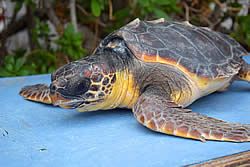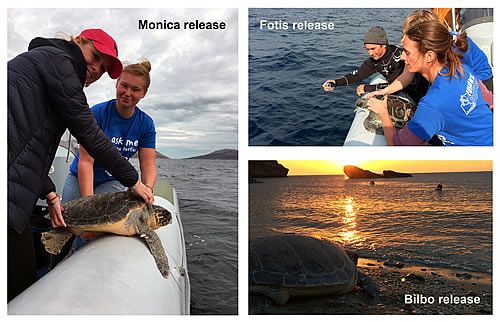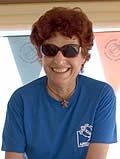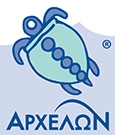Joanne, whatʼs new at the Rescue Centre (November 2016)?
Our volunteer at the Rescue Centre Joanne Stournara updates us on the events from 1-30 November 2016.
‘It might as well be spring’ (Rodgers and Hammerstein song title)

Turtle news
Arrivals / Deaths
‘Iphigenia’ arrived from Leros on 3 November 2016 with possible hypothermia, sent by a member of ARION Cetacean Rescue and Rehabilitation Center. She has no visible injuries, and X-rays reveal she has no ingested hooks, lines, or other detectable problems. Although she is not eating by herself yet, she can dive and is getting more active. She will be spending the winter in the Intensive Care Unit at the RC.
Many thanks to Dr Michalis Kontragouris for his valuable help in rescuing this turtle (and others).
(The turtle was named after the ancient Greek princess Iphigenia, the daughter of the great Mycenaean king Agamemnon and his wife Clytemnestra. Iphigenia’s is a long and interesting story, but in short, she was sacrificed by Agamemnon to the goddess Artemis.)
‘Hades’, an adult male loggerhead whose carapace measured 76cm, arrived on 21 November 2016 from Preveza with a horrific head injury deliberately inflicted by a human. Unfortunately, due to the severity of his injury, he was put down on 23 November 2016. (In ancient Greek mythology, Hades was the brother of Zeus and Poseidon. When the brothers drew lots to divide the rule of the universe, Hades ‘won’ the position of Lord of the Underworld and the Dead.)
‘Kiatou’ arrived on 17 November 2016 from the Port of Kiatou with a visible ingested hook. Unfortunately, she died on the same day. A necropsy revealed she had a second hook inside her, each of which was attached to a separate fishing line. These items caused internal injuries, leading to her death.
‘Spyros’, the small loggerhead (6.5 kilos) who had arrived at the RC from Legrena on 9 October 2016, died on 19 November 2016. The turtle had an ingested hook and line which was impossible to surgically remove because of its location within his body.
‘Kotsina’, a loggerhead whose carapace measured 60.5 cm and who weighed 22 kilos, arrived on 27 November 2016 with injuries to her head and carapace. She had been found stranded on the beach at Kotsina on the Aegean Island of Limnos and sent to the RC by the port police. Unfortunately, she died shortly after her arrival due to the severity of her injuries.
We would like to thank everyone involved in helping to rescue these injured turtles.
Releases
Fortunately, because of the unusually favorable weather conditions this month, nine rehabilitated turtles were released back into the sea. Photos and more information about these and other turtle releases can be found on the official ARCHELON FB page. You can access the page via this link https://www.facebook.com/archelon.gr/posts/10154479381291328:0 or by a link to the FB page on the ARCHELON website home page www.archelon.gr.
‘Monica’, who had arrived at the RC on 14 June 2016 from Thessaloniki with a head injury, was released on 4 November 2016 by boat into the Saronic Gulf.
‘Akeso’, from Elafonisos (Crete), arrived on 13 August 2015 with carapace and flipper injuries. He was successfully rehabilitated and released on 13 November 2016 into the Saronic Bay.
‘Phoebe’ is an example of how patience is important when treating turtles with head injuries. She had arrived at the RC on 29 October 2012, gradually regained her health and abilities to dive, find food, etc., and was released on 13 November 2016.
‘Mimi’, who had arrived on 13 September 2016 from Skopelos with an ingested hook and flipper injuries, was released on 13 November 2016 into the Saronic Gulf.
‘Polymnia’ had been found by members of the ARCHELON Kyparissia field team during the summer 2016 season. She was treated successfully and released on 14 November 2016.
‘Sofia’ arrived at the RC on 30 June 2015 from Kalamata with carapace injuries. She was successfully treated and released on 14 November 2016 into the Saronic Gulf.
‘Bilbo’ was released on 18 November 2016 from Katafugi beach, Attica. He had arrived at the RC on 31 July 2016 from Kefalonia with injuries to his carapace and plastron, as well as an ingested hook.
‘Alexandra’ arrived on 26 February 2015 from Rodos. Her head injury was successfully treated, and she was released on 24 November 2016 from Katafugi, Attica.
‘Fotis’ was released on 25 November 2016 by boat into the Saronic Gulf. He had arrived at the RC on 24 June 2015 from Katafugi with head and flipper injuries.

Updates/Progress Reports
‘Giorgos’ is enjoying the good weather outdoors in the big outdoor tank. He has improved greatly, and is managing to dive more frequently. He is able to reach his food at the bottom of the big tank, which is good news. He is not well enough to be released this year, but hopefully next year he will be free again!
Twenty-two turtles will be treated at the Centre over the winter. Out of the 22, 14 have head injuries. Head injuries take a long time to heal, but in some cases patience pays off. For example, ‘Phoebe’ and ‘Eos’ had both been at the Centre for some time, but both recovered their health and were / will be released in 2016 (‘Phoebe’ in November, and ‘Eos’ in December).
Did you know...
The terms ‘overwinter’ and ‘brumation’ refer to how sea turtles survive during the cold winter months. Because sea turtles are members of the reptile family, they are cold-blooded, which means they cannot adjust their body temperature according to weather conditions. So how do sea turtles overwinter (i.e. survive through the winter)? Some migrate to areas with sea temperatures greater than 15oC, and some brumate, which is a special term used to describe a state of relative inactivity in a reptile. In the case of sea turtles, this means that they are able to stay underwater for long periods of time without swimming to the surface to breathe. It is hard to track and study sea turtles thoroughly enough to acquire sufficient and appropriate data to do a scientific analysis of their overwintering behavior.
However, according to an interesting study published online, the “duration and maximum depth were obtained for a total of 1952 dives and dive profiles were available for 229 of these. Median dive durations increased from a minimum of 5.5 min in July to a maximum of 341 min in February. The maximum recorded dive duration was 410 min. Surfacing intervals after such long dives lasted between 5 and 7 min. The increase in dive duration coincided with the decrease in SST and the change of season.” (2005, Hochscheid, S., Bentivegna F. and G.C. Hays, The Royal Society Publishing, Biology Letters, https://www.ncbi.nlm.nih.gov/pmc/articles/PMC1629053/).

RECENT NEWS
- OUR NEWS05/12/2025
Saving Sea Turtles Together – A Tribute to Volunteers
On Volunteer Day, we take a moment to celebrate all those who came from near and far, put on the blue T-shirt, and embraced this important responsibility.
- OUR NEWS01/12/2025
Laganas Bay, Zakynthos: Successful Loggerhead Reproduction, Ongoing Habitat Problems
On the beaches of the Zakynthos National Marine Park, around 2,155 turtle nests successfully hatched thanks to active protection measures, but human pressures on coastal and marine habitats continue.
- OUR NEWS26/11/2025
A Second Chance: Two Loggerhead Sea Turtles Return to the Sea Thanks to Dedicated Rescues
This summer, two adult loggerhead sea turtles, ‘Aktaia’ and ‘Herbert’, arrived at ARCHELON’s Sea Turtle Rescue Centre needing urgent help after sustaining severe head injuries.
- OUR NEWS11/11/2025
Volunteering Projects 2026: Sea Turtles Need You, the Planet Needs Us!
ARCHELON welcomes volunteers from all over the world and of all ages (over 18) and no prior experience is required! If you speak English, are at least 18 years old, and are in good physical condition, you can do this!
- OUR NEWS10/11/2025
Outstanding Recognition for ARCHELON at the Effective Dialogue Conference 2025
On Thursday, November 6, 2025, ARCHELON received an honorary distinction for its substantial contribution to effective dialogue on sustainability, social responsibility, and the environment
- OUR NEWS06/11/2025
6th Year of Online Tours: The sea turtles are traveling across Greece once again!
Students from every corner of the country, as well as from international schools, have the opportunity to learn up close about the lives of the turtles cared for at the Sea Turtle Rescue Centre in Glyfada, Attica, and to discover how rescue efforts impact the marine world.
- OUR NEWS31/10/2025
The lecture turned into reality: A real turtle rescue for the students from Kallithea!
The students spotted a sea turtle floating in the water right after their educational tour of the ARCHELON Rescue Centre and immediately notified the rescuers.
- OUR NEWS24/10/2025
Filming of the LIFE MareNatura documentary is completed
From seabird monitoring and genetic sampling, to unique underwater footage of marine mammals, the testimonies of scientists bring to life the hidden stories of the sea.
- OUR NEWS23/10/2025
ARCHELON participates in the "Science Festival 2025 – The Voice of the Ocean"
The French Institute of Greece is organizing a celebration from 10 to 27 November 2025 dedicated to science and the ocean! World premiere of the LIFE MareNatura documentary on November 13th.
- OUR NEWS22/10/2025
Kyparissia Bay: ARCHELON Records 6,100 Nests and Calls on the State to Immediately Implement the National Action Plan for the Loggerhead
In 2025 approximately 6,100 nests were recorded, marking a 74% increase compared to the average of the previous 12 years!
- OUR NEWS10/10/2025
We bid farewell to a devoted environmentalist and friend, Yiannis Roussopoulos.
- OUR NEWS02/10/2025
Jane Goodall’s words still warm our hearts
Thank you, Dr. Goodall, for all that you have taught us and for the life example you have left behind.
- OUR NEWS29/09/2025
Turtles, Dolphins, and Birds: Local Communities and Scientists come together for the future of Amvrakikos Gulf
A one-day conference held on Wednesday, September 24, in Menidi, Amfilochia, united the voice of the local community with leading scientists and environmental organizations for Amvrakikos Gulf.
- OUR NEWS26/09/2025
Biologists from the 'LIFE ADAPTS' project send their message to the community
- OUR NEWS23/09/2025
Aquila Rithymna Beach Hotel becomes an Advocate for ARCHELON in Rethymno
The hotel's generous donation directly supports the costs of conservation activities during the 2025 and 2026 nesting seasons.


